21 October, 2004
Rounding 'em up at the Penguin Ranch.
Today I had the opportunity to go to the "Penguin Ranch" to see the first arrivals of the emperor penguins that spend a few weeks of their summer vacation as research subjects.
Stacy was kind enough to arrange for me to join Dr. Paul Ponganis's research group from Scripps Institution of Oceanography in California. They study the diving physiology of emperor penguins. In other words, they look to see what happens to the penguins' bodies when they dive, in parcticular, how their heart rates and oxygen use change.
Emperor penguins are champion divers. They can dive for up to 22 minutes at a time, and as deep as 500 meters (1640 feet - more than a quarter of a mile). Dr. Ponganis knows this because he attaches recorders to the penguins that measure their temperature, heart rate, and oxygen levels. He wants to know how these birds can hold their breath for such a long time.
He has discovered that one way in which penguins are different from humans is that, when we humans hold our breath, we store most of it in our lungs (as you know if you've ever held your breath, which of course, you have). When penguins hold their breath, however, they store half of it in their muscles, and rest is divided about evenly between their blood and their lungs.
An interesting thing also happens to penguins' heart rates when they dive. A penguin's resting heart rate is 60 to 70 beats per minute, not that different from a human's. Just before they dive, the heart rate goes up to 180 to 200 beats per minute to get more oxygen into their muscles. Then when they dive, the heart rate drops right away to about 100 beats per minute and eventually goes all the way down to 20! With the slowed down heart rate, the penguin is using oxygen much more slowly, therefore conserving it so it can stay down longer. The body temperature stays the same throughout the dive. When the penguin returns to the surface, its heart rate goes way up again at first before settling back to the resting heart rate.
Dr. Ponganis is also a medical doctor, and the information that he learns from penguins about how tissues can survive low-oxygen conditions might be useful in learning how to preserve organs that are going to be transplanted into people!
Another device, designed in Japan, can be attached to the penguin to record its movements and actual swimming behavior. The penguins at the penguin ranch also have had underwater cameras - the National Geographic Crittercam - attached to them. Using these cameras, researchers hope to learn more about what penguins are doing when they're diving.
I rode out to the penguin Ranch with Ed, who has spent a number of seasons in Antarctica, and is doing his first science program with the penguin group. He opened the observation tube, or "ob tube" for me. This is a tube that goes down into a little observation room under the ice. I climbed down the ladder inside the tube - a somewhat tight fit - and entered the room, which is big enough for one person or maybe two very squished people. There are four windows with thick glass that allow the person inside the "ob tube" to see in all directions.
It is incredibly beautiful under the water, which is very deep so I couldn't see the bottom. For the first time, I could see what the sea ice looks like from underneath. There are beautiful little delicate flat pieces of ice that fan out like flowers. Looking straight up, the ice is white, but the farther away you look, the bluer it becomes. The water itself is a deep, deep blue.
There were two holes in the ice not far from me; these are the holes cut for the penguins to enter and exit the water. Underneath two of the huts, there are also holes in the rice. The reason these holes were cut is that seals had discovered the penguins' holes, and were using them to breathe. This interfered with the penguins, so two more holes were made and the seals got used to using those holes instead. The doors in the floor can be lifted to look at the seals when they come up. I was able to see four or five seals go up to those holes, where they would stay for a few minutes, then slowly turn and dive again until they disappeared into the blue depths.
I was in the observation tube for over an hour, and when there were no seals, I had lots of plankton to watch drifting by. There were copepods, tiny jellyfish, a big white jellyfish that had flowing tentacles and was at least as big as a dinner plate, tiny squirmy things (unidentified), comb jellies, and lots of very small round things that may have been eggs.
Another thing I observed in the tube was the Pisten Bully going over the ice above me! I could hear it move and saw the shadow go over the ice above me. How weird to have a big vehicle driving over my head!
I finally decided to leave the ob tube, although I think I really could have stayed in there all day, and a few minutes later, the helicopter arrived. The scientists had flown over to the other side of Ross Island, near Beaufort Island, to catch the penguins. The penguin ranch is about 15 miles from McMurdo, but the edge of the sea ice is father away, and penguins need to have some open water so they can hunt.
The scientists catch the penguins by walking up to them, or even letting the penguins approach them. Then they have an aluminum pole with the end curved into a hook. There are two flexible rubber tubes stretched across the hook that help cushion the penguin. The penguin catcher puts the hook around the penguin, then quickly pulls it in, grabs it, and puts it into the garbage can. The key is not to let it slide on its belly, or else it will get away.
The helicopter landed right on the ice near the ranch, and out came five big plastic garbage cans with the lids tied on. I helped carry one and could feel the penguin moving around inside. The can was quite heavy - I couldn't tell quite how much it weighed, since I was carrying it with the helicopter pilot, but it must have been 40 or more pounds.
The birds were taken to the fenced-in area and tipped out of the cans. They slid across the ice for a little while on their bellies, but soon were standing up and waddling around, exploring their new surroundings. It didn't take them long to appear to get comfortable , since a few of them came in my direction to check me out. They are very curious animals and will walk right up to people to look at them. They are big, too. These would probably reach my waist if they were standing next to me. They can be over a meter tall.
It was soon time for me to go back to the station on the helicopter. Dr. Ponganis and Ed were going to stay at the camp. Torrie, a scientist in the lab and also Ed's wife, and Jessica, a graduate student, returned in the helicopter too. The view from the helicopter was beautiful and Torrie showed me what was left of the path that the icebreaking ship had cut last year. Jessica had a very exciting day today. She had flown in a helicopter for the first time, caught penguins for the first time, and later in the evening, she arranged a conference call to McMurdo from her friend who is at the International Space Station right now! Not bad for a day's work.
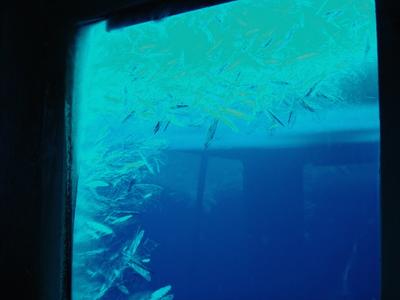
1. Looking out the observation tube. The windows is surrounded by beautiful ice crystals.
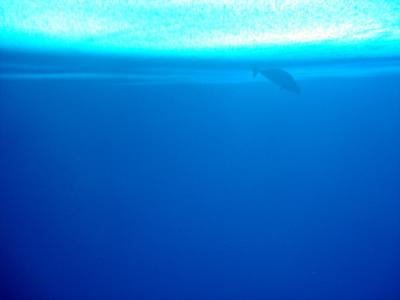
2. A Weddell seal dives after visiting the breathing hole under one of the penguin ranch huts.

3. As the helicopter approaches from the other side of Ross Island, we have our fingers crossed that penguins are aboard.
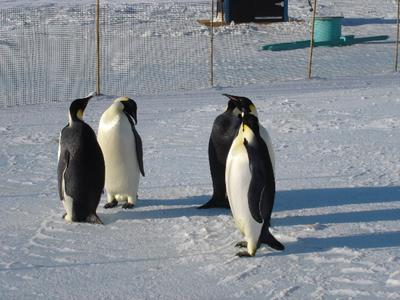
4. "Hey George, weren't we here last year?"
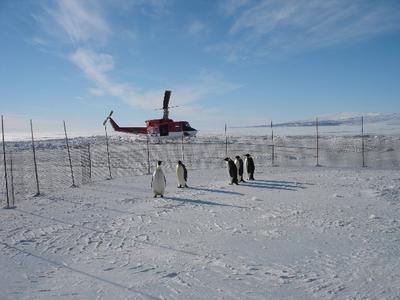
4. Where are we??!!
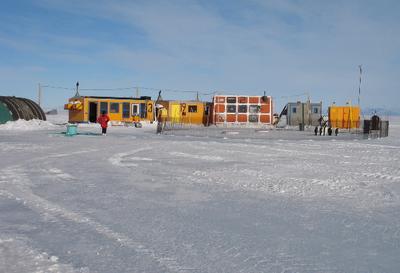
10. Goodbye to the penguin ranch. The scientists will live and work here until December.

7. After a short time in the "corral," the penguins begin to relax.
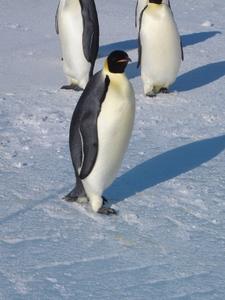
8. The penguins start coming closer to check me out.

9. "Where's our dive hole?" (Notice the pink "cookie" covering the dive hole in the background. This reduces the amount of ice that forms on the surface of the open hole.
Contact the TEA in the field at
.
If you cannot connect through your browser, copy the
TEA's e-mail address in the "To:" line of
your favorite e-mail package.
|
